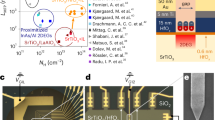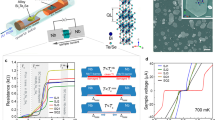Abstract
The electric-field effect control of two-dimensional electron gases (2-DEGs) has allowed nanoscale electron quantum transport to be explored in semiconductors. Structures based on transition metal oxides have electronic states that favour the emergence of novel quantum orders that are absent in conventional semiconductors and the 2-DEG formed at a LaAlO3/SrTiO3 interface—a structure in which superconductivity and spin–orbit coupling can coexist—is a promising platform to develop devices for spintronics and topological electronics. However, field-effect control of the properties of this interface at the nanoscale remains challenging. Here we show that a quantum point contact can be formed in a LaAlO3/SrTiO3 interface through electrostatic confinement of the 2-DEG using a split gate. Our device exhibits a quantized conductance due to ballistic transport in a controllable number of one-dimensional conducting channels. Under a magnetic field, the direct observation of the Zeeman splitting between spin-polarized bands allows the determination of the Landé g-factor, whose value differs strongly from that of the free electrons. Through source–drain voltage measurements, we also performed a spectroscopic investigation of the 3d energy levels inside the quantum point contact. The LaAlO3/SrTiO3 quantum point contact could potentially be used as a spectrometer to probe Majorana states in an oxide 2-DEG.
This is a preview of subscription content, access via your institution
Access options
Access Nature and 54 other Nature Portfolio journals
Get Nature+, our best-value online-access subscription
$29.99 / 30 days
cancel any time
Subscribe to this journal
Receive 12 digital issues and online access to articles
$119.00 per year
only $9.92 per issue
Buy this article
- Purchase on Springer Link
- Instant access to full article PDF
Prices may be subject to local taxes which are calculated during checkout




Similar content being viewed by others
Data availability
The data that support the plots within this paper and other findings of this study are available from the corresponding author upon reasonable request.
References
Alicea, J. New directions in the pursuit of Majorana fermions in solid state systems. Rep. Prog. Phys. 75, 076501 (2012).
Stern, A. & Lindner, N. H. Topological quantum computation—from basic concepts to first experiments. Science 339, 1179–1184 (2013).
DasSarma, S., Freedman, M. & Nayak., C. Majorana zero modes and topological quantum computation. npj Quantum Inf. 1, 15001 (2015).
Mourik, V. et al. Signatures of Majorana fermions in hybrid superconductor–semiconductor nanowire devices. Science 336, 1003–1007 (2012).
Finck, A. D. K., Van Harlingen, D. J., Mohseni, P. K., Jung, K. & Li, X. Anomalous modulation of a zero-bias peak in a hybrid nanowire–superconductor device. Phys. Rev. Lett. 110, 126406 (2013).
Churchill, H. O. H. et al. Superconductor–nanowire devices from tunneling to the multichannel regime: zero-bias oscillations and magnetoconductance crossover. Phys. Rev. B 87, 241401(R) (2013).
Zhang, H. et al. Quantized Majorana conductance. Nature 556, 74–79 (2018).
Hwang, H. Y. et al. Emergent phenomena at oxide interfaces. Nat. Mater. 11, 103–113 (2012).
Ohtomo, A. & Hwang, H. Y. A high-mobility electron gas at the LaAlO3/SrTiO3 heterointerface. Nature 427, 423–426 (2004).
Hurand, S. et al. Field-effect control of superconductivity and Rashba spin–orbit coupling in top-gated LaAlO3/SrTiO3 devices. Sci. Rep. 5, 12751 (2015).
Stornaiuolo, D. et al. Weak localization and spin–orbit interaction in side-gate field effect devices at the LaAlO3/SrTiO3 interface. Phys. Rev. B 90, 235426 (2014).
Caviglia, A. D. et al. Electric field control of the LaAlO3/SrTiO3 interface ground state. Nature 56, 624–627 (2008).
Valentinis, D. Modulation of the superconducting critical temperature due to quantum confinement at the LaAlO3/SrTiO3 interface. Phys. Rev. B 96, 094518 (2017).
Singh, G. et al. Competition between electron pairing and phase coherence in superconducting interfaces. Nat. Commun. 9, 407 (2018).
Singh, G. et al. Gap suppression at a Lifshitz transition in a multi-condensate superconductor. Nat. Mater. 18, 948–954 (2019).
Caviglia, A. D. et al. Tunable Rashba spin–orbit interaction at oxide interfaces. Phys. Rev. Lett. 104, 126803 (2010).
Ben Shalom, M., Sachs, M., Rakhmilevitch, D., Palevski, A. & Dagan, Y. Tuning spin–orbit coupling and superconductivity at the SrTiO3/LaAlO3 interface: a magnetotransport study. Phys. Rev. Lett. 104, 126802 (2010).
Singh, G. et al. Effect of disorder on superconductivity and Rashba spin–orbit coupling in LaAlO3/SrTiO3 interfaces. Phys. Rev. B 96, 024509 (2017).
Lesne, E. et al. Highly efficient and tunable spin-to-charge conversion through Rashba coupling at oxide interfaces. Nat. Mater. 15, 1261–1266 (2016).
Vaz, D. C. et al. Mapping spin–charge conversion to the band structure in a topological oxide two-dimensional electron gas. Nat. Mater. 18, 1187–1193 (2019).
Fu., L. & Kane, C. L. Superconducting proximity effect and Majorana fermions at the surface of a topological insulator. Phys. Rev. Lett. 100, 096407 (2008).
Stornaiuolo, D. et al. Signatures of unconventional superconductivity in the LaAlO3/SrTiO3 two-dimensional system. Phys. Rev. B 95, 140502(R) (2017).
Kuerten, L. et al. In-gap states in superconducting LaAlO3/SrTiO3 interfaces observed by tunneling spectroscopy. Phys. Rev. B 96, 014513 (2017).
van Wees, B. J. et al. Quantized conductance of point contacts in a two-dimensional electron gas. Phys. Rev. Lett. 60, 848–850 (1988).
Wimmer, M., Akhmerov, A. R., Dahlhaus, J. P. & Beenakker., C. W. J. Quantum point contact as a probe of a topological superconductor. New J. Phys. 13, 053016 (2011).
Beenakker, C. W. J. Search for Majorana fermions in superconductors. Annu. Rev. Condens. Matter Phys. 4, 113–136 (2013).
Rossler, C. et al. Transport properties of clean quantum point contacts. New J. Phys. 13, 113006 (2011).
Salluzzo, M. et al. Orbital reconstruction and the two-dimensional electron gas at the LaAlO3/SrTiO3 interface. Phys. Rev. Lett. 102, 166804 (2009).
Berner, G. et al. Direct k-space mapping of the electronic structure in an oxide–oxide interface. Phys. Rev. Lett. 110, 247601 (2013).
Stornaiuolo, D. et al. In-plane electronic confinement in superconducting LaAlO3/SrTiO3 nanostructures. Appl. Phys. Lett. 101, 222601 (2012).
Buttiker, M. Quantized transmission of a saddle-point constriction. Phys. Rev. B 41, 7906(R) (1990).
Biscaras, J. et al. Limit of the electrostatic doping in two-dimensional electron gases of LaXO3(X = Al,Ti) /SrTiO3. Sci. Rep. 4, 6788 (2014).
Kirczenow, G. Theory of the conductance of ballistic quantum channels. Solid State Commun. 68, 715–718 (1988).
Thierschmann, H. et al. Transport regimes of a split gate superconducting quantum point contact in the two-dimensional LaAlO3/SrTiO3 superfluid. Nat. Commun. 9, 2276 (2018).
Prawiroatmodjo, G. E. D. K. et al. Transport and excitations in a negative-U quantum dot at the LaAlO3/SrTiO3 interface. Nat. Commun. 8, 395 (2017).
Kouwenhoven, L. P. et al. Nonlinear conductance of quantum point contacts. Phys. Rev. B 39, 8040 (1989).
Patel, N. K. et al. Properties of a ballistic quasi-one-dimensional constriction in a parallel high magnetic field. Phys. Rev. B 44, 10973 (1991).
Glazman, L. I. & Khaetskii, A. V. Nonlinear quantum conductance of a point contact. JETP Lett. 48, 591–595 (1988).
Salis, G. et al. Electrical control of spin coherence in semiconductor nanostructures. Nature 414, 619–622 (2001).
Annadi, A. et al. Quantized ballistic transport of electrons and electron pairs in LaAlO3/SrTiO3 nanowires. Nano Lett. 18, 4473–4481 (2018).
Martin, T. P. et al. Enhanced Zeeman splitting in Ga0.25In0.75 as quantum point contacts. Appl. Phys. Lett. 93, 012105 (2008).
Cancellieri, C. et al. Polaronic metal state at the LaAlO3/SrTiO3 interface. Nat. Commun. 7, 10386 (2016).
Kim, M., Kozuka, Y., Bell, C., Hikita, Y. & Hwang, H. Y. Intrinsic spin–orbit coupling in superconducting δ-doped SrTiO3 heterostructures. Phys. Rev. B 86, 085121 (2012).
Herranz, G. et al. Engineering two-dimensional superconductivity and Rashba spin–orbit coupling in LaAlO3/SrTiO3 quantum wells by selective orbital occupancy. Nat. Commun. 6, 6028 (2015).
Tekman, E. & Ciraci, S. Theoretical study of transport through a quantum point contact. Phys. Rev. B 43, 7145–7169 (1991).
Debray, P. et al. All-electric quantum point contact spin-polarizer. Nat. Nanotechnol. 4, 759–764 (2009).
Ngo, A. T., Debray, P. & Ulloa, S. E. Lateral spin–orbit interaction and spin polarization in quantum point contacts. Phys. Rev. B 81, 115328 (2010).
Kohda, M. et al. Spin–orbit induced electronic spin separation in semiconductor nanostructures. Nat. Commun. 3, 1082 (2012).
Acknowledgements
We acknowledge M. Aprili, A. Caviglia, A. Akhmerov, R. Citro, M. Grilli, S. Caprara and L. Benfatto for stimulating discussions. This work was supported by the French RENATECH network (French national nanofabrication platform), the Région Ile-de-France in the framework of C’Nano IdF, OXYMORE and Sesame programs, by CNRS through a Projet International de Coopération Scientifique (PICS) programme and by the Agence Nationale de la Recherche (ANR) Projet de Recherche Collaborative (PRC) (QUANTOP). We acknowledge funding received from the project Quantox of QuantERA ERA-NET Cofund in Quantum Technologies (Grant Agreement no. 731473) implemented within the European Union’s Horizon 2020 Program. The authors also acknowledge the European Cooperation in Science and Technology (COST) project Nanoscale coherent hybrid devices for superconducting quantum technologies Action CA16218.
Author information
Authors and Affiliations
Contributions
A.J. and G.S. performed the measurements under the supervision of N.B. Samples were fabricated by E.L. and D.C.V. under the supervision of A.B. and M.B. Nanofabrication processes were performed by A.J. and C.U. A.J., G.S., C.F.-P., J.L. and N.B. carried out the analysis of the results. A.J. and N.B. wrote the Article with the help of J.L. M.S. and M.B. All the authors contributed to discussions of the results and commented on the final manuscript.
Corresponding author
Ethics declarations
Competing interests
The authors declare no competing interests.
Additional information
Publisher’s note Springer Nature remains neutral with regard to jurisdictional claims in published maps and institutional affiliations.
Supplementary information
Supplementary Information
Supplementary Sections 1–5, Figs. 1–4 and refs. 1–2.
Rights and permissions
About this article
Cite this article
Jouan, A., Singh, G., Lesne, E. et al. Quantized conductance in a one-dimensional ballistic oxide nanodevice. Nat Electron 3, 201–206 (2020). https://doi.org/10.1038/s41928-020-0383-2
Received:
Accepted:
Published:
Issue Date:
DOI: https://doi.org/10.1038/s41928-020-0383-2
This article is cited by
-
A clean ballistic quantum point contact in strontium titanate
Nature Electronics (2023)



